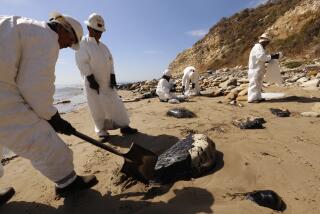Exxon Ducks Committal to Cleanup Plan : But Firm ‘Will Put It Right’ in Alaska, Official Promises Panel
- Share via
WASHINGTON — Under intense prodding by members of Congress, a top Exxon executive declined Friday to commit his firm to follow an Alaskan oil spill cleanup plan not yet drafted by the government, but he promised that Exxon “will put it right” in the oil-fouled area.
Meanwhile, President Bush warned Exxon not to break its pledge to clean up the devastating spill, saying that he was pleased with the work accomplished so far but would take action if the company left the scene “prematurely.”
Exxon U.S.A. President William D. Stevens told a House subcommittee that the company plans to halt cleanup efforts during the harsh Alaskan winter. But, he said, the firm will return to Alaska in the spring to help survey remaining environmental damage.
The oil tanker Exxon Valdez ran aground in Alaska’s Prince William Sound in March, spilling 11 million gallons of crude oil into the water and fouling beaches and marine environments throughout the area.
In testimony before the House Interior subcommittee on water, power and offshore energy resources, Stevens carefully hedged promises of future action by the firm in response to a detailed cleanup plan to be devised by the U.S. Coast Guard.
“My expectation, based on past experiences, is that there will be no differences of view” that would cause Exxon to reject the plan, he said. If the company balked at the proposals, the government could take over the cleanup effort and try to bill Exxon for the cost.
“We will follow through on any reasonable request,” Stevens assured members of the House subcommittee. But he stopped short of pledging that the company would accept the government’s cleanup blueprint before it is complete.
“Exxon’s decision to comply or not is theirs to make,” observed Rep. George Miller (D-Martinez), chairman of the subcommittee. “The Coast Guard is in the position of the public trust at this point.”
Miller’s comments came as Exxon and the federal government are debating whether the cleanup could be substantially accomplished before mid-September, when stormy weather conditions could halt most work in the affected area.
A July 19 internal Exxon memo from Otto R. Harrison, the company’s cleanup supervisor, warned that Exxon would demobilize its cleanup crews for the winter and “our only commitment for the spring of 1990 is to survey the shorelines.”
Warns Against Commitments
In the directive to Exxon employees managing the cleanup, Harrison said: “No commitment should be made to any private or government party on timing of demobilization, for winter activity or for 1990 activity.”
“The wording of Mr. Harrison’s memo was unfortunate,” Stevens told the House panel. “What we’re doing every day . . . would say we will follow through.”
After months of cleanup efforts that have cost Exxon $675 million, Stevens said, about 600 of 725 miles of coastline affected by the spill have been cleaned enough to render them “environmentally stable.”
But those claims came under attack by Rep. Wayne Owens (D-Utah), who brandished oil-soaked rocks taken recently from a beach that had been cleaned, and from Dennis D. Kelso, Alaska’s commissioner of environmental conservation.
“The job’s not done, and I think you’re doing it in the wrong way,” said Owens. “There’s restoration here as well as cleanup. And that job hasn’t been started.”
But the Coast Guard, the agency designated to judge the adequacy of Exxon’s efforts, appeared willing to compromise on holding Exxon to the stricter standard of environmental restoration.
“I don’t think we’ll ever see it immaculately clean and restored to the pristine condition it had been in,” said Vice Adm. Clyde T. Lusk Jr., vice commander of the Coast Guard.
When scientists and engineers return in the spring to survey remaining environmental damage, Lusk said, “we will probably find some scientists will tell us that further cleanup will do more environmental harm than good.”
While Stevens said that Exxon currently has no detailed winter demobilization plan, he defended the expected withdrawal of large ships and equipment from the spill area in mid-September. Wind speeds above 40 knots and waves over six meters high begin occurring regularly in September and would threaten the safety of workers and equipment, he said.
Exxon is to present a demobilization plan to Coast Guard Adm. Clyde Robbins by Aug. 11.
But Kelso, the Alaska environmental official, said that the cleanup could proceed in some affected areas well into the fall and winter.
Some equipment and personnel must be available in case winds and tides begin blowing large oil deposits into unaffected or previously cleaned areas, Kelso said.
More to Read
Sign up for Essential California
The most important California stories and recommendations in your inbox every morning.
You may occasionally receive promotional content from the Los Angeles Times.











